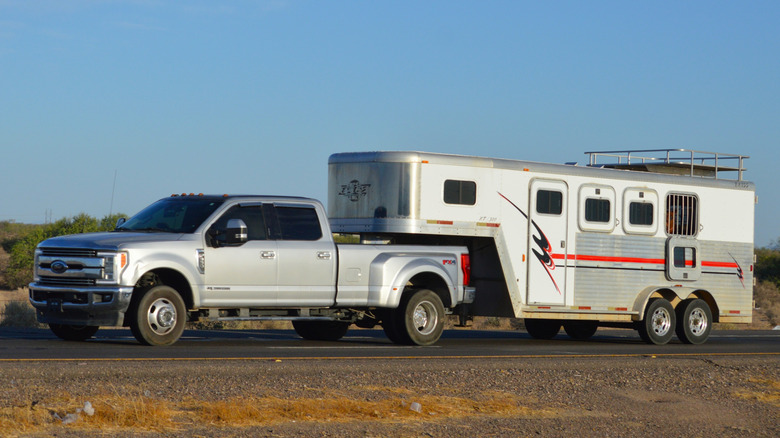Can You Install A Trailer Hitch On Any Car? Here's What You Should Know
The ability to tow a camper or boat on your adventures opens up a world of possibility. However, not every vehicle out on the road has a trailer hitch installed. What you may not know is that almost every vehicle is capable of towing, and vehicles without trailer hitches can have them installed. Most owners can install one themselves, though some may prefer to have a local mechanic or their dealership install it. It's important to note, the owner's manual of your vehicle should indicate what the manufacturer's recommended maximum tow rating for the vehicle is, that will show how much your vehicle can tow.
Before you even think about installing a trailer hitch on your vehicle you need to figure out what type of hitch works with your specific vehicle. There are six different types of trailer hitches, Class 1, Class 2, Class 3, Class 4, Class 5, and Gooseneck hitches. Class 1 hitches are designed for smaller vehicles and can tow up to 2,000 pounds. On the other end of the spectrum, Gooseneck hitches, also known as fifth wheels, are only found on pickup trucks and give drivers the ability to tow loads up to 30,000 pounds.
Each class of trailer hitch has its own specific frame that needs to be installed on the vehicle and has a tongue weight that cannot be exceeded. Similar to how the Class 1 hitches are designed for smaller towing loads, they also have a lower maximum tongue weight capacity.
Trailer hitch classes explained
Class 1 trailer hitches can be installed on compact and midsize cars, such as the Honda Accord. These trailers can tow up to 2,000 pounds, which is the equivalent of a six-foot trailer or a small fishing boat up to 14-feet long. Class 1 hitches have a maximum tongue rating of 200 pounds and use a 1.25-inch receiver.
Class 2 trailer hitches can be installed on midsize cars, minivans, and midsize SUVs, such as the Subaru Legacy or the Chrysler Pacifica. These trailers are capable of towing up to 3,500 pounds, which is the equivalent of a 12-foot trailer or a 20-foot fishing boat. Class 2 hitches use a 1.25-inch heavy duty receiver and have a maximum tongue weight of 350 pounds.
Class 3 and 4 trailer hitches can be installed on minivans, midsize SUVs, full-size cars, trucks, and large SUVs. Class 3 and 4 trailers are where the tow numbers start to jump up, as it's capable of towing up to 10,000 pounds. That is about equivalent to towing a small car or a sailboat. Class 3 trailer hitches are 2-inch undercar receivers and have a maximum tongue weight of 1,000 pounds.
Finally, Class 5 receivers can tow up to 20,000 pounds and Gooseneck hitches can tow up to 30,000 pounds. Class 5 hitches can only be installed on full-size pickups, large vans, and full-size SUVs. Gooseneck trailers can only be installed on pickup trucks.
The basics of trailer hitch installation
Step one in installing a trailer hitch is determining which class of hitch you'll need. Using our helpful guidelines above, you should be able to decide which is the best for your vehicle. The next step is to jack up the back end of your vehicle, and be sure to use a jack stand to support the weight of the vehicle.
Next, read the installation guide included with the hitch that you purchased. Depending on the type of hitch, you may be required to remove different areas of the vehicle before the hitch can be mounted. Once that is done, be sure to clean the mounting area with a wire brush to rid the metal of rust.
Make sure the hitch is placed underneath the mounting points and prop the hitch to make it easier to fasten the bolts. Once the bolts and nuts are fastened, make sure they are tightened to whatever the installation guide tells you.
AutoZone has a guide on the tools necessary to complete a hitch installation. They recommend wheel chocks, safety glasses, a screwdriver set, a ½-inch socket and ratchet, combination wrenches, a torque wrench, a pry bar, and a wire brush. AutoZone says those are must-have tools for this project.


